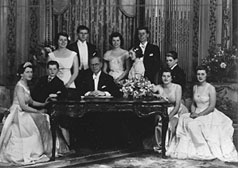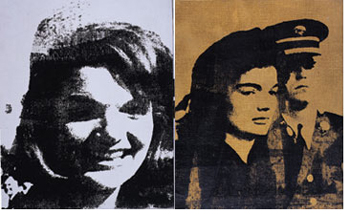Looking Back
Without the shock and massive grief caused by President
John F. Kennedy's assassination, a lot of events
might not have occurred—or might have had
very different outcomes.
Consider the evidence.
In the late ‘50s and
early ‘60s, we experienced post-war prosperity;
relaxing of a rigid social structure; the birth
of rock ‘n’ roll; the dawn of the media
age; the space race; the Cold War; and the growth
of the civil rights movement.
Kennedy had eased
the Russian threat somewhat; he had hoped to
address civil rights in his second
term.
And he wanted to get us out of Vietnam.
We had yet to view the TV-news horror of that “conflict,” which
prompted protests by draft-fearing youth who, for
the first time, challenged authority and the status
quo.“Hell no, we won’t go” morphed
into a huge generation gap fueled by the notions
of free love, rock ‘n’ roll and the credo, “Turn
on, tune in, drop out.”
But during Kennedy’s reign, we still accepted
the presidency as a sacrosanct position and respected
those who held it. “When the American government
told you something was right, you believed it,” says
Dr. Cyril Wecht, Allegheny County coroner and
nationally acclaimed forensic science expert.
That was before
Lyndon Johnson’s policies produced revelations
that not all wars are justified and presidents
do lie; before Richard Nixon irrevocably turned
us into
cynics and caused the rise of investigative journalism.
On
the 40th anniversary of Kennedy’s death,
we find ourselves looking back to examine why
and how that event had such a monumental effect.
 The Kennedys
The Kennedys
To those who believe in the forces of Good and Evil,
the idea of a curse sitting on the heads of Joseph
P. Kennedy’s male descendants is totally
believable.
Consider the evidence. Each one of the patriarch’s
sons suffered a cruel fate: His namesake was killed
in World War II; both John and Bobby were felled
by assassins’ bullets; Teddy nearly died in
a 1964 plane crash, then was involved in a scandal
that kept him from the White House. Some of their
progeny have met equally gruesome fates, including
the last Kennedy presidential prospect, John F. Kennedy
Jr., who piloted his plane to a watery grave. President
Kennedy’s second son, Patrick, died two days
after his birth—just a few months before his
father was buried.
Popular culture helps to perpetuate
the Kennedy Curse. For example, a song by New Zealand
singer Shona Laing
zeroes in on the Kennedy family’s suffering
with a sharpshooter’s accuracy. In (Glad I’m)
Not A Kennedy, the chorus repeats: “Wearing
the fame like a loaded gun/Tied up with a rosary/I’m
glad I’m not a Kennedy.”
“Wearing the fame like a loaded gun.” That
was the concept Andy Warhol sought to convey when
he
began his artistic obsession with JFK’s
stoic widow, who not only represented the pinnacle
of
beauty and fame, but who also knew how to manipulate
the
media. Warhol craved similar fame and control,
and may have turned to her for lessons.
Yet even
when Warhol achieved notoriety himself, he
still remained awed by Jackie and what he
regarded as her skill at manipulating the public’s
perception of her. Though it is legitimate to
question whether
Jackie was still performing a role years after
the assassination, there is no doubt that Warhol
reveled
in playing one himself—and in his ability
to cultivate his own persona.
“He was a creation from head to toe,” says The
Andy Warhol Museum Director Thomas Sokolowski. “He
was an artwork. She didn’t go that far.”
Creating Camelot
Already larger than life in the eyes of many adoring
Americans, Jack Kennedy became a superhero as soon
as he died. His wife became a grieving Madonna
figure, a dignified, yet heartrending symbol of
America's loss—of both its president and
its innocence. The public willingly accepted the
idea that her husband's 1,000 days in office took
place in an idyllic time that “for one brief
shining moment … was known as Camelot.”
Jackie
introduced the notion of Camelot in a post-assassination
interview she gave to friend Theodore H. White
for Life magazine. White ran with it, and unwittingly
helped spin the fairytale he later came to regard
as exactly that.
Warhol ran with it, too, despite his expressed
disdain for the inescapable coverage of the events
surrounding
Kennedy’s death. While Warhol hated the idea
that the first major news event played out on TV
came with the implication that everyone should have
media-directed feelings of sadness and grief, his
assassination silkscreens make it clear that he did
experience those emotions—and actually helped
perpetuate them.
“Warhol was always push-pull,” says
Sokolowski. “There
were often dichotomies between what he said and
what he did.”
 With his trademark use of repeated images, Warhol
immortalized several frozen-in-time moments
from before and after the assassination in Jackie
(the Week that Was), and Sixteen Jackies. First she
is shown with a smile and her cocked pillbox
hat, then
she’s a stunned wife, and finally, a set-lipped
mourner. Warhol also turned those images into
separate pieces, and created his now-familiar
portrait of
Jackie as a lovely-looking first lady. A few
years later, he produced his powerful Flash,
a series of
silkscreens depicting a grinning president, his
glamorous wife, a presidential seal with bullet
holes through
it, an ad for an Italian carbine rifle, and other
symbolic representations of that tragedy.
With his trademark use of repeated images, Warhol
immortalized several frozen-in-time moments
from before and after the assassination in Jackie
(the Week that Was), and Sixteen Jackies. First she
is shown with a smile and her cocked pillbox
hat, then
she’s a stunned wife, and finally, a set-lipped
mourner. Warhol also turned those images into
separate pieces, and created his now-familiar
portrait of
Jackie as a lovely-looking first lady. A few
years later, he produced his powerful Flash,
a series of
silkscreens depicting a grinning president, his
glamorous wife, a presidential seal with bullet
holes through
it, an ad for an Italian carbine rifle, and other
symbolic representations of that tragedy.
Ruth Ann Rugg, director of interpretation at
Dallas’ Sixth
Floor Museum at Dealey Plaza, a collaborator
with The Andy Warhol Museum on the exhibition,
notes: “Warhol
of all people was fascinated with publicity,
with public attention. … He was, I think,
really aware of how much this one event had
captured the
attention of the whole nation.”
The constant
replay of assassination footage also reinforced
Warhol’s own use of repetition.
And in keeping with Warhol’s catholic
background, Rugg says, “He more or less
did elevate Jackie to the status of a saint.”
As Sokolowski notes: “Had (Kennedy) not been
killed, she would only have been the pretty first
lady.”
The Mystery
At first, the public believed what it was told: that
Lee Harvey Oswald acted alone. But once the distrust
set in, people started questioning the validity
of that explanation.
Stephen Fagin, oral history coordinator at the Dealey
Plaza museum, suggests, “After Watergate, people
thought, ‘If they lied to us about this, did
they lie to us about the Kennedy assassination?’
“It just becomes this big question mark,” Fagin
says. “The
mystery endures because it is a mystery.”
Wecht, who discovered the lack
of forensic record-keeping in the Kennedy case says we’re also still
saddened by the loss of a young, dashing, Pulitzer Prize-winning, World War
II hero with all that unfulfilled promise. Combined
with our disbelief in our government and continuing questions about the evidence
he says, “You have a case that will not die.”
Wecht, a proponent
of the conspiracy theory, also served as a consultant on Oliver Stone’s
1991 feature film, JFK, which exposed a new generation of Americans to
the events surrounding Kennedy’s life and assassination. After the
movie was released, says Fagin, “From that point on, the assassination
was a current event.”
Every day, Fagin says, people come to the plaza, “And
they mill around and look, as if somewhere, out there, the answer is
still there.”
As if he were quoting a script
from The X-Files, Fagin adds, “The more
you look, the more confusing it becomes.” n